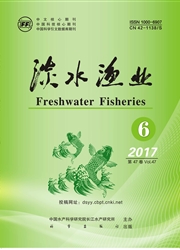

 中文摘要:
中文摘要:
研究了养殖密度对饲料驯化期西伯利亚鲟(Acipenser baerii)稚鱼生长和存活的影响。试验设置5个养殖密度(1.843、1.638、1.433、1.228、1.024 kg/m^3)。试验期间采用依次投喂水蚯蚓、软颗粒饲料、硬颗粒饲料的驯养方法,逐步从活饵料转喂人工配合颗粒饲料。试验结果表明,最大密度组D1溶解氧达到最低值4.09 mg/L,接近鲟鱼正常生长发育的临界溶氧;高密度组D1、D2、D3和低密度组D4、D5死亡率和终体重差异显著(P〈0.05);D3特定生长率(SGR)均值最大,D1、D2和D3、D4、D5的SGR差异显著(P〈0.05);D4的终体重、日增重(DWG)、肥满度(CF)最大,各密度组对DWG、CF和体长及体重变异系数(CV)的影响较小(P〉0.05)。试验期间从D1到D5组的死亡率依次为2.06%,1.99%,1.87%,1.68%和1.64%,CF为0.498~0.532,SGR平均值为11.16%~13.14%,体重CV为30.72%~33.54%,体长的CV为6.64%~9.94%。根据试验结果,建议饲料驯化期西伯利亚鲟稚鱼的适宜养殖密度控制在1.228~1.433 kg/m^3,即直径2 m的玻璃缸每缸3 000~3 500尾。
 英文摘要:
英文摘要:
The effects of stocking density on the growth and survival of juvenile Acipenser baerii were studied.Experimental fish were reared in five different stocking density(1.843,1.638,1.433,1.228,1.024 kg/m^3) for 10 days.After 10 d domestication,we found the dissolved oxygen of the biggest density group D1 dropped from 5.96 to 4.09 mg/L,which was close to normal growth and development of sturgeon(4 mg/L).The mortality and final weight of higher density group D1,D2 and D3 and lower density group D4,D5 were significant difference(P〈0.05).The average specific growth rate(SGR) of D3 was the largest,and SGR of D1 and D2 were significant different from D3,D4 and D5(P〈0.05).The maximum values of final body weight,daily weight gain(DWG) and condition factor were found in D4.And DWG,CF,the coefficient variation(CV) of the weight and length was not significantly affected by stocking density(P〉0.05).The mortality rate of 5 group from D1 to D5 were 2.06%,1.99%,1.87%,1.68%,and 1.64%,respectively,CF ranged from 0.498 to 0.532,the average SGR was 11.16%~13.14%,the body weight CV ranged from 30.72% to 33.54%,and the body length CV ranged from 6.64% to 9.94%.The results demonstrated that it was suitable to domesticate the juvenile Siberian sturgeon in density of 1.228 to1.433 kg/m^3,namely 3 000 to 3 500 tail of every pond of 2 meters in diameter.
 同期刊论文项目
同期刊论文项目
 同项目期刊论文
同项目期刊论文
 期刊信息
期刊信息
